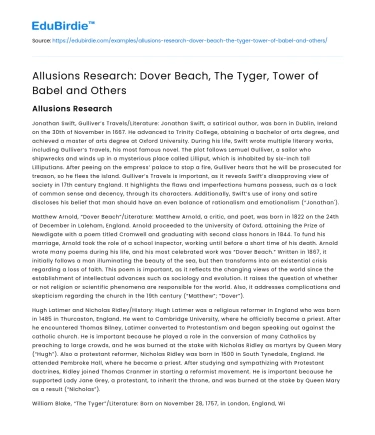Introduction
Literary allusions are a profound means through which writers enrich their narratives, embedding layers of meaning that transcend the immediate text. By invoking themes and symbols from established works, authors connect with a shared cultural and literary heritage. This essay examines allusions in notable works such as "Dover Beach" by Matthew Arnold, "The Tyger" by William Blake, and the Tower of Babel narrative from religious texts, among others. These allusions serve not only as a bridge between texts but also as a tool for deeper exploration of universal themes such as faith, fear, and human ambition. By analyzing these works, we gain insight into how allusions operate within literature to enhance thematic depth and reader engagement, while also addressing potential counterpoints to the efficacy of such devices.
Symbolism and Faith in "Dover Beach"
Matthew Arnold's "Dover Beach" is a poignant exploration of the loss of faith in the modern world, and its allusions are central to conveying this theme. Arnold's reference to the "Sea of Faith" juxtaposes the once-full tide of religious certainty with the current ebb, reflecting a Victorian era grappling with scientific advancements and diminishing religious belief. The poem's allusion to Sophocles, who "heard it on the Ægean," connects the contemporary crisis of faith with a historical continuum of human suffering and existential contemplation. This allusion enriches the poem by suggesting that the turmoil faced by Arnold's contemporaries is part of a larger, timeless human experience.
Save your time!
We can take care of your essay
- Proper editing and formatting
- Free revision, title page, and bibliography
- Flexible prices and money-back guarantee
Critics might argue that Arnold's reliance on historical allusions could distance modern readers unfamiliar with these references. However, the emotional resonance of the imagery and the universal theme of searching for meaning in a world perceived as chaotic ensures that the poem remains impactful. The evocative language and vivid imagery, such as the "eternal note of sadness," bridge the gap between past and present, inviting the reader to consider their position within this continuum. Thus, while the specific allusions may require some historical knowledge, the poem's emotional core remains accessible and powerful.
The Dichotomy of Creation in "The Tyger"
William Blake's "The Tyger" is a masterful exploration of the duality of creation, with its allusions to biblical and mythological ideas. The poem's central question, "What immortal hand or eye, / Could frame thy fearful symmetry?" alludes to the paradox of a creator capable of both beauty and terror, mirroring the biblical narrative of creation. Blake's reference to fire imagery, such as "burning bright" and "distant deeps or skies," draws on the Promethean myth, emphasizing the dangerous yet enlightening power of creation.
Blake's allusions serve to question the nature of the divine, portraying a complex and ambivalent view of God as both benevolent and fearsome. This complexity invites readers to reflect on their understanding of divinity and the moral implications of creation. While some may argue that Blake's dense allusions can obscure the poem's message, they are integral to its exploration of the dichotomy inherent in creation. By engaging with these allusions, readers are challenged to consider the coexistence of light and dark, beauty and horror within the natural world.
The Ambition and Hubris of the Tower of Babel
The Tower of Babel narrative, as recounted in religious texts, serves as a powerful allusion to human ambition and the consequences of hubris. This story, which describes humanity's attempt to build a tower reaching the heavens, only to be thwarted by divine intervention, is a cautionary tale about the limits of human endeavor. The allusion to Babel is frequently employed in literature to underscore themes of fragmentation, confusion, and the perils of overreaching.
For instance, in works like Thomas Pynchon's "Gravity's Rainbow," the Babel motif highlights the chaotic and fragmented nature of modern society. The allusion serves as a critique of technological advancement and the quest for power, echoing the biblical warning against unchecked ambition. While some might contend that such allusions risk alienating readers without religious backgrounds, they nevertheless offer a rich tapestry of meaning for those who engage with them, enabling a critical examination of contemporary issues through the lens of ancient wisdom.
Conclusion
In conclusion, literary allusions serve as a vital mechanism for enriching narratives, allowing authors to draw on a deep well of cultural and historical significance. Through the examination of works such as "Dover Beach," "The Tyger," and the Tower of Babel narrative, we see how allusions enhance thematic complexity and invite readers into a dialogue with the past. While there is a risk of alienating some readers, the enduring power of allusions lies in their ability to transcend time and provoke thoughtful reflection. By engaging with these symbols and references, readers are encouraged to explore the multifaceted nature of human experience, bridging the gap between individual perception and collective understanding.






 Stuck on your essay?
Stuck on your essay?

